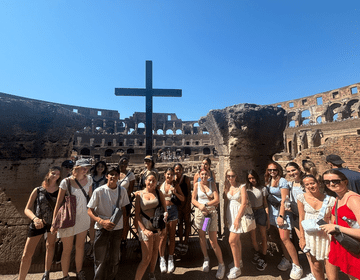The Life Cycle of a Painting
After a week of classes, excursions, and workshops dedicated to learning more about ancient Roman art, architecture and artifacts, the focus of the program has now shifted to consider another popular art form: painting. Once the students returned from the Papal Audience on Wednesday morning, the students once again entered the classroom to participate in a workshop about conservation. The students learned about the different techniques used to restore various types of art, such as frescoes and oil paintings, and they were able to try them first-hand. At one work station, participants practiced rebuilding a Roman anaphora, but it was the second activity that stole the show. For the past ten days, our classes have been held in a nunnery, and the space is decorated with various religious statues and paintings. We were lucky enough to be able to practice our restoration techniques on one of their paintings, which dates back to the 1800s! See the gallery above for the impressive before and after pictures.
Today, the students continued their foray into the world of painting by creating their own frescoes, a là Michelangelo. Participants first learned about the process of making the dyes, and were able to hold the different rocks and minerals from which the colors are derived. They also got to see the ingredients that go into the most important part of a fresco, the plaster (made from a mixture of sand, limestone, marble powder, and water). The Italian word fresco means "fresh", in reference to the wet plaster on top of which the paint is applied. Students followed the same steps that Michelangelo would have to create the Sisten Chapel. They were able to choose a design (a grotesque, one of Michelangelo's sibyls, or the hands of Adam and God), and transfer it onto tracing paper. Small holes must then be poked along the lines of the drawing. This paper is then laid on top of the plaster, and a small pouch of red-colored powder is tapped over the holes, leaving a trail of dots behind on the plaster. Then, a wet paintbrush is used to connect the dots before filling in the design with a base color, shadows, and highlights. As students finished their frescoes, the instructors commented on how impressed they were with the level of artistic talent possessed by our group!
Our students left their masterpieces to dry before continuing on to the final activity of the day. Since the fresco workshop showed students how a fresco is born, and the restoration workshop showed how a painting's lifespan can be lengthened, it was now time for our participants to witness some of the greatest-known frescoes in person. We arrived in the Vatican Museums, first observing ancient Roman and Greek statues whose depictions of anatomy served as sources of inspiration for Michelangelo's painting, such as the Laocoön and the Belvedere Torso. We then walked through rooms full of Etruscan pottery, Renaissance tapestries, and enormous maps of Italy until we arrived at our final destination: the Sistine Chapel. Students gazed up in awe at two of Michelangelo's masterpieces: the Sistine Chapel ceiling that depicts stories from the Old Testament alongside prophets and sibyls, and the painting entitled "The Last Judgment" that covers the back wall of the chapel. Our participants had now experienced the process of fresco-making from beginning to end, undoubtedly gaining a new appreciation for this style of art in the process.
As if this incredible two-day exploration of frescoes was not enough, we made our way over to St. Peter's Basilica. Once inside the massive church, participants were given free time to explore the interior, taking in the marble decorations, mosaics, and sculptures. We ended our day by taking in yet another famous work by Michelangelo: his Pietà, a marble statue that he completed at the young age of 23!
Related Posts
Lost in Florence: Finding Art in Every Corner
When Sam writes an article, you know the students are waking up early! Let's set aside thoughts of the Colosseum and the ancient Romans for a moment because we’re about... keep reading
Once Upon a time … in Tivoli!
Nestled in the Italian region of Lazio, the charming town of Tivoli is a testament to Italy's rich historical tapestry and natural beauty. Just a short drive from Rome, Tivoli has been a favored retreat since ancient times, offering a perfect blend of natural splendor and architectural marvels. Among its many attractions, Villa d’Este stands out as a jewel of Renaissance architecture and landscape design.
Rome-ing with CIEE: Colossal Adventures at the Colosseum and Forum!
The alarm rang a bit earlier today, signaling the start of an exciting day for the students and their Program Leaders as they embarked on their first bus ride in... keep reading














